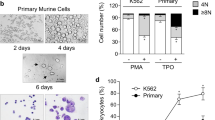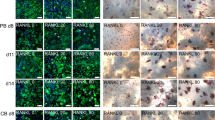Summary
There is increasing evidence that 1,25 dihydroxyvitamin D3 acts directly to differentiate and activate cells of mononuclear phagocyte lineage (MNP). However, it seems possible that in bone marrow this hormone may modulate the differentiation of MNP via the factor elaborated by the stromal cells or the macrophages. We tested this hypothesis using two separate culture systems of bone marrow cells from vitamin D-replete (D+) and-deficient (D−) rats. The animals were maintained from the third day of lactation on D+ or D− diet for up to 105 days.In vivo studies showed that the long-term D− state resulted in a depletion of acid phosphatase-positive macrophagelike cells and osteoclasts in bones. After a 14 day incubation period, cultures of D− bone marrow cells contained an increased number of fibroblastoid cell colonies and a reduced number of macrophages attached to fibroblastoid cells, compared with the controls. When D+ bone marrow cells were cultured for 4 days in the presence of supernatants obtained from 14 day cultures of D− bone marrow (marrow adherent cell-conditioned medium, MACCM), the differentiation of MNP into macrophages was inhibited. Impaired differentiation was almost complete in D− bone marrow cell cultures to which D− MACCM was added. These cultures consisted of only 6.6% macrophages compared with 53.9% in the control cultures. However, when D− bone marrow cells were cultured with D+ MACCM, differentiation was restored and 75.4% of the cells were macrophages. These results suggest that a paucity of macrophages and osteoclasts in D− rats is in part, if not entirely, a result of a failure of stromal cells and/or macrophages in the bone marrow to release a factor(s) necessary for differentiation of MNP and osteoclast precursors.
Similar content being viewed by others
References
Raisz LG, Trummel CL, Holick MF, DeLuca HF (1972) 1,25-dihydroxycholecalciferol: a potent stimulator of bone resorption in tissue culture. Science 175:768–769
Holtrop ME, Raisz LG (1979) Comparison of the effects of 1,25-dihydroxycholecalciferol, prostaglandin E2, and osteoclast-activating factor with parathyroid hormone on the ultrastructure of osteoclasts in cultured long bones of fetal rats. Calcif Tissue Int 29:201–205
Rodan GA, Martin TJ (1981) Role of osteoblasts in hormonal control of bone resorption—a hypothesis. Calcif Tissue Int 33:349–351
Bar-Shavit Z, Noff D, Edelstein S, Meyer M, Shibolet S, Goldman R (1981) 1,25-Dihydroxyvitamin D3 and the regulation of macrophage function. Calcif Tissue Int 33:673–676
Provvedini DM, Tsoukas CD, Deftos LJ, Manolagas SC (1983) 1,25-Dihydroxyvitamin D3 receptors in human leukocytes. Science 221:1181–1183
Mangelsdorf DJ, Koeffler HP, Donaldson CA, Pike JW, Haussler MR (1984), 1,25-Dihydroxyvitamin D3-induced differentiation in a human promyelocytic leukemia cell line (HL-60): receptor-mediated maturation to macrophage-like cells. J Cell Biol 98:391–398
Abe E, Miyaura C, Tanaka H, Shiina Y, Kuribayashi T, Suda S, Nishii Y, DeLuca HF, Suda T (1983) 1,25-Dihydroxyvitamin D3 promotes fusion of mouse alveolar macrophages by both a direct mechanism and a spleen-mediated indirect mechanism. Proc Natl Acad Sci USA 80:5583–5587
Jowsey J (1972) Calcium release from the skeletons of rachitic puppies. J Clin Invest 51:9–15
Ash P, Loutit JF, Townsend KMS (1980) Osteoclasts derived from haematopoietic stem cells. Nature 283:669–670
Dexter TM (1982) Stromal cell associated haematopoiesis. J Cell Physiol, Suppl 1:87–94
Wiktor-Jedrzejczak W, Ahmed A, Szczylik C, Skelly RR (1982) Hematological characterization of congenital osteopetrosis on op/op mouse: possible mechanism for abnormal macrophage differentiation. J Exp Med 156:1516–1527
Nakamura T, Toyofuku F, Kanda S (1985) Whole-body irradiation inhibits the escape phenomenon of osteoclasts in bones of calcitonin-treated rats. Calcif Tissue Int 37:42–45
Goud TJLM, Schotte C, van Furth R (1975) Identification and characterization of the monoblast in mononuclear phagocyte colonies grown in vitro. J Exp Med 142:1180–1199
Bar-Shavit Z, Teitelbaum SL, Reitsma PH, Hall A, Pegg LE, Trial J, Kahn AJ (1983) Induction of monocytic differentiation and bone resorption by 1,25(OH)2D3. Proc Natl Acad Sci USA 80:5907–5911
Reitsma PH, Rothberg PG, Astrin SM, Trial J, Bar-Shavit Z, Hall A, Teitelbaum SL, Kahn AJ (1983) Regulation and myc gene expression in HL-60 leukemia cells by a vitamin D metabolite. Nature 306:492–494
Bar-Shavit Z, Kahn AJ, Teitelbaum SL (1983) Defective binding of macrophages to bone in rodent osteomalacia and vitamin D deficiency. J Clin Invest 72:526–534
Key LL, Carnes DL, Greenberger J, Weichselbaum R, Anast CS (1984) Normal human bone marrow undergoes cellular differentiation and produce a factor(s) when exposed to calcitriol in vitro. Calcif Tissue Int 36:517 (abstract)
Ashton BA, Eaglesom CC, Bab I, Owen ME (1984) Distribution of fibroblastic colony-forming cells in rabbit bone marrow and assay of their osteogenic potential by an in vivo diffusion chamber method. Calcif Tissue Int 36:83–86
Burger EH, van der Meer JWM, Van de Gevel JS, Bribnau JC, Thesingh CW, van Furth R (1982) In vitro formation of osteoclasts from long-term cultures of bone marrow mononuclear phagocytes. J Exp Med 156:1604–1614
Gowen M, Wood DD, Ihrie EJ, McGuire MKB, Russell RGG (1983) An interleukin I like factor stimulates bone resorption in vitro. Nature 306:378–380
Amento EP, Bhalla AK, Kurnick JT, Kradin RL, Clemens TL, Holick SA, Holick MF, Krane SM (1984) 1,25-Dihydroxyvitamin D3 induces maturation of the human monocyte cell line U937, and, in association with a factor from human T lymphocytes, augments production of the monokine, mononuclear cell factor. J Clin Invest 73:731–739
McCarthy DM, Hibbin JA, Goldman JM (1984) A role for 1,25-dihydroxyvitamin D3 in control of bone marrow collagen deposition? Lancet 78–80
Author information
Authors and Affiliations
Rights and permissions
About this article
Cite this article
Nakamura, T., Araki, K., Kanda, S. et al. Normal bone marrow adherent cell-conditioned medium corrects the impaired differentiation of cultured mononuclear phagocytes from vitamin D-deficient rats. Calcif Tissue Int 38, 33–37 (1986). https://doi.org/10.1007/BF02556592
Received:
Revised:
Issue Date:
DOI: https://doi.org/10.1007/BF02556592




